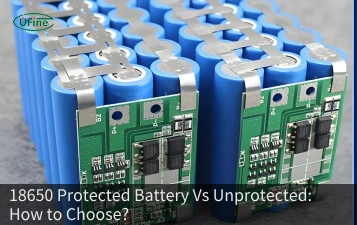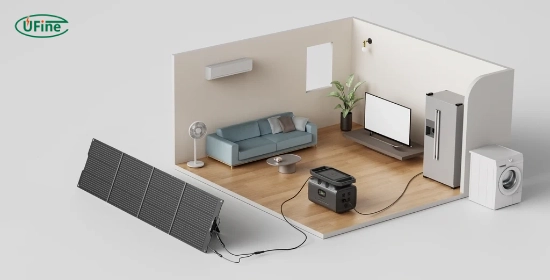
- Part 1. What is a house battery backup system?
- Part 2. How does a whole house battery backup system work?
- Part 3. Why is a house battery backup system important?
- Part 4. House battery backup vs. generator: Which should you choose?
- Part 5. Key components of a whole house battery backup system
- Part 6. How to size a house battery backup system?
- Part 7. Best house battery backup systems in 2025
- Part 8. How much does a whole house battery backup system cost?
- Part 9. Can a house battery backup system work with solar panels?
- Part 10. How is a house battery backup system installed?
- Part 11. FAQs about house battery backup
Looking for a house battery backup system that can keep your home running during a blackout? A whole-house battery backup system is the ultimate solution for home energy security. It provides automatic, reliable power during outages without noise, fumes, or fuel dependency. If you’re considering a more innovative, cleaner backup energy solution, this guide covers everything you need to know.
Part 1. What is a house battery backup system?
A house battery backup system is an energy storage solution that powers your home when the primary electrical grid fails. It stores electricity for later use, supplying power to essential systems and appliances during outages.
These systems work automatically. When a power outage occurs, the battery backup system detects the interruption and immediately begins supplying electricity to your home. This switch is seamless, ensuring your lights stay on, your refrigerator keeps running, and your devices remain charged.
Unlike portable generators, house battery backups are quiet, clean, and can operate indoors. They are often paired with solar energy systems to provide sustainable, renewable backup power.
Part 2. How does a whole house battery backup system work?
A whole house battery backup system operates by charging itself from the grid or solar panels when electricity is available. It monitors the status of the power supply continuously. As soon as an outage is detected, the system activates and redirects stored energy into your home’s electrical circuits.
This process involves several technical components:
- A battery bank stores the electrical energy.
- An inverter converts the stored direct current (DC) electricity into alternating current (AC), which your home uses.
- An automatic transfer switch detects outages and shifts the power source from the grid to the battery.
- A monitoring system tracks usage and performance, often accessible through a mobile app.
Some systems also prioritize energy to specific circuits, ensuring essentials like lighting, refrigeration, and internet equipment stay active.
Part 3. Why is a house battery backup system important?
Power outages can happen for many reasons, such as storms, wildfires, overuse of the grid, or aging infrastructure. With the rising frequency of these events, having a house battery backup system is more crucial than ever.
Here are key reasons why homeowners are investing in these systems:
- Reliable emergency power: You remain safe and comfortable even during extended outages
- Energy independence: You reduce reliance on utility companies and their fluctuating rates
- Environmental benefits: Battery systems produce no emissions, unlike gas-powered generators
- Silent operation: No noise pollution in your home or neighborhood
- Clever energy use: Some systems can shift usage to times when electricity is cheaper
In areas prone to outages or with unstable electricity supply, a battery backup system is not just a luxury but a necessity.
Part 4. House battery backup vs. generator: Which should you choose?
Choosing between a house battery backup and a traditional generator depends on your needs, but battery systems offer many advantages. Here’s a detailed comparison:
| Feature | House Battery Backup | Generator |
|---|---|---|
| Noise | Completely silent | Loud during operation |
| Fuel Requirements | Electricity or solar | Gasoline, diesel, or propane |
| Maintenance | Minimal | Frequent oil and filter changes |
| Environmental Impact | Zero emissions | High carbon emissions |
| Indoor Safety | Safe for indoor use | Not safe indoors |
| Automation | Fully automatic | May require manual operation |
| Long-Term Cost | Lower over time | Higher due to fuel and upkeep |
While generators may have a lower upfront cost, battery backups provide a cleaner, safer, and more modern solution.
Part 5. Key components of a whole house battery backup system
To understand how these systems operate, it’s essential to recognize their main components:
Battery Bank: This is where electricity is stored. The capacity of the battery determines how long your home can remain powered during an outage.
Inverter: This device converts the DC electricity stored in the battery into AC electricity used by household appliances.
Automatic Transfer Switch (ATS): This component detects a power outage and instantly switches the power source from the grid to the battery backup.
Monitoring and Control System: These systems allow homeowners to monitor battery performance, charge levels, and energy usage in real-time, usually through an app.
Solar Integration (Optional): A solar-compatible backup system can recharge during the day using sunlight, extending backup capacity and lowering electricity costs.
Each part plays a role in ensuring your home remains powered during an outage.
Part 6. How to size a house battery backup system?
Choosing the right size for your house battery backup system is essential for performance and cost-efficiency. If the battery is too small, it may not meet your needs. If it’s too large, you may overspend on capacity you don’t use.
To properly size your system, consider the following:
- Evaluate total household power consumption over 24 hours
- List high-priority appliances that need to run during an outage, such as refrigerators, medical devices, lighting, Wi-Fi routers, and heating or air conditioning
- Factor in the number of hours or days you want the system to provide power without recharging
- Consider future energy needs, like electric vehicles or home expansions
- Consult with a licensed installer to perform a load calculation and create a customized plan
Professional installers can design a solution that fits your home’s electrical load and lifestyle, ensuring you get the best performance from your system.
Part 7. Best house battery backup systems in 2025
Here are five top-rated house battery backup systems in 2025 known for reliability, efficiency, and smart design:
1. Tesla Powerwall 3
Tesla’s Powerwall 3 is one of the most popular residential battery systems available. It offers a usable capacity of 13.5 kWh and can be stacked for greater storage. It includes real-time monitoring and integrates seamlessly with Tesla solar systems.
2. LG Energy Solution RESU Prime
The LG RESU Prime offers up to 16 kWh of storage and supports scalable modules. It is known for its compact design and high energy efficiency. It is compatible with various hybrid inverters and smart home systems.
3. Generac PWRcell
Generac’s PWRcell system offers up to 18 kWh of storage and is modular, allowing you to expand capacity as needed. It features intelligent load management and is designed for solar integration, making it ideal for long-term energy savings.
4. Enphase IQ Battery
This system is known for its reliability and microinverter-based architecture. It offers modular designs starting at 3.5 kWh and scales as needed. The Enphase App provides detailed monitoring and energy control.
5. Uifne Battery
Uifne Battery offers customized battery backup solutions tailored to your home’s unique energy profile. With access to diverse energy resources and advanced energy management software, Uifne can design flexible, scalable systems that integrate with solar power and support a wide range of home energy needs. Their team specializes in helping homeowners create reliable and efficient backup systems that match both budget and lifestyle.
Each of these systems has its advantages, and the best choice depends on your power needs, location, and budget.
Part 8. How much does a whole house battery backup system cost?
The cost of a whole house battery backup system varies based on capacity, brand, labor, and whether solar panels are included. Here’s a general breakdown:
| System Size | Estimated Installed Cost |
|---|---|
| Small (10 kWh) | $8,000 to $12,000 |
| Medium (15–20 kWh) | $12,000 to $18,000 |
| Large (30+ kWh) | $20,000 to $30,000+ |
Additional costs may include electrical upgrades, permits, and integration with solar systems. The good news is that many homeowners qualify for federal tax credits, which can reduce the total cost by up to 30 percent. Some states and utility providers also offer rebates.
Part 9. Can a house battery backup system work with solar panels?
Yes, modern house battery backup systems work exceptionally well when combined with solar panels. This setup allows your battery to recharge during the day, even when the grid is down.
Benefits of combining solar with battery backup include:
- Extended backup time during long outages
- Lower electricity bills through self-consumption
- Energy independence from the grid
- Eligibility for more incentives and rebates
Many systems, like Tesla Powerwall and Uifne Battery solutions, are designed to integrate with solar and can manage energy flow automatically between the grid, solar panels, and battery.
Part 10. How is a house battery backup system installed?
Installing a house battery backup system is a technical process that requires professional expertise. Here’s a general overview:
- Energy assessment: A professional evaluates your home’s power usage and electrical system.
- System design: Based on your needs, a detailed plan is created, including battery capacity, location, and potential solar integration.
- Permitting: Necessary permits and utility approvals are obtained.
- Installation: The battery, inverter, transfer switch, and monitoring system are installed and connected to your home’s main panel.
- Testing and activation: The system is tested for functionality and safety. Monitoring apps are configured so you can track performance.
Installation usually takes one to three days, depending on complexity. Always use certified professionals to ensure compliance with local codes and safety standards.
Part 11. FAQs about house battery backup
How long can a battery backup system power a home?
A typical battery backup system can power essential appliances for 12 to 48 hours, depending on the battery size and power demands. Larger systems or those paired with solar panels can last much longer.
Can I go entirely off-grid with a house battery system?
Yes, but going off-grid requires a large battery storage capacity and a reliable solar energy system. Most homeowners choose a hybrid approach for flexibility and savings.
Are battery backup systems safe for residential use?
Yes, modern battery systems are built with multiple safety features, including thermal management, surge protection, and automatic shutdown. Brands like Tesla and LG are certified for home use.
What maintenance does a house battery system require?
Battery systems are low maintenance. Unlike generators, they do not need fuel, oil changes, or regular servicing. Occasional checks and software updates are usually sufficient.
Are there incentives for installing a house battery backup system?
Yes. The federal government offers a 30% tax credit on the total cost of battery systems. Many states and utilities provide additional rebates, especially when paired with solar.
Related Tags:
More Articles

18650 Protected Battery VS Unprotected: Which One Is Better?
Discover the differences between protected and unprotected 18650 batteries. Learn which type offers better safety and performance for your device.
How to Choose the 18650 Vape Battery?
How to choose the 18650 vape battery? Deciphering capacity, discharge rates, and compatibility. This guide equips users with insights for informed decisions.
18650 Battery 2600mAh: Specifications, Recommend, Applications
18650 batteries: rechargeable lithium-ion used in electronics. 2600mAh variant known for longevity, high energy density, reliable performance.
Top 10 11.1V LiPo 3S Battery Models in 2025
Explore our curated list of the 10 best 11.1V 3S LiPo batteries. Find reliable options that enhance your devices' performance and longevity.
How Long Do Rechargeable Vape Batteries Last?
Learn about the lifespan of rechargeable vape batteries, factors that impact their longevity, and tips to keep them performing at their best.



